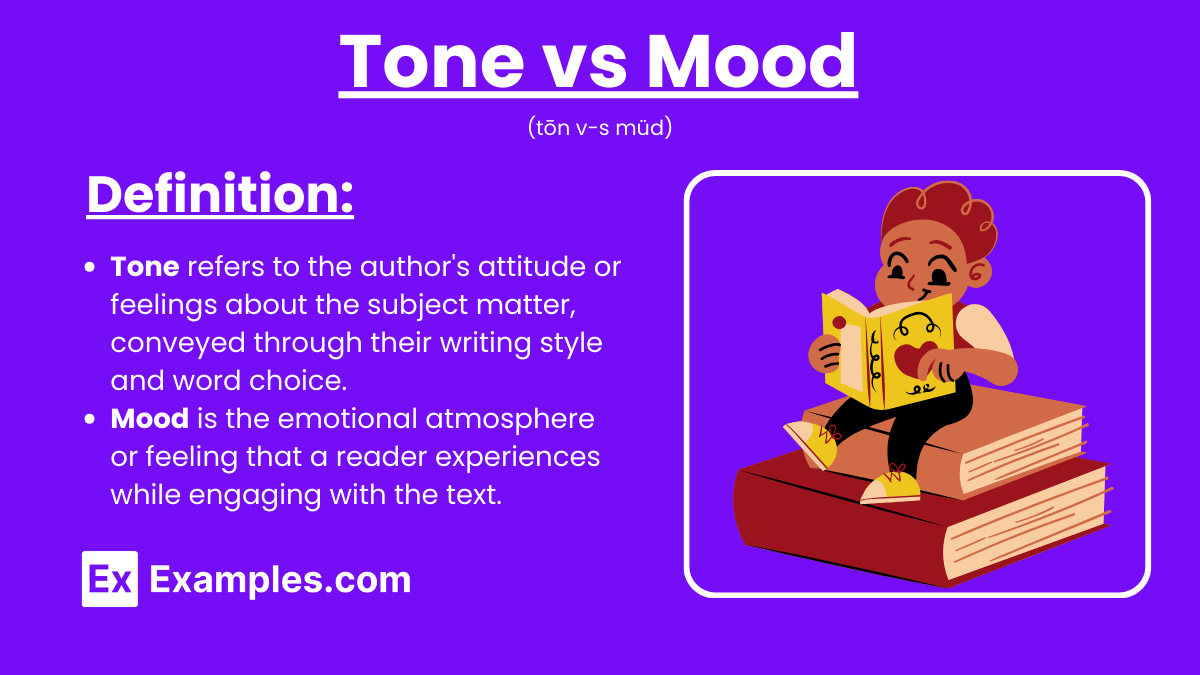30+ Tone vs Mood Examples
In literature, understanding the distinction between tone and mood is crucial for comprehending the depth of a text. Tone refers to the author’s attitude towards the subject, conveyed through stylistic choices and diction, while mood is the emotional atmosphere that a reader experiences. For instance, a writer’s use of personification and alliteration can significantly influence the mood, evoking specific feelings and images. To grasp the mood better, readers often refer to mood words and utilize tools like a mood board to visualize the emotions and themes within a story.
What is Tone?
Tone is the author’s attitude or perspective towards the subject matter or audience, conveyed through their stylistic choices and word selection. It shapes how readers perceive the emotions and underlying messages in the text.
What is Mood?
Mood is the emotional atmosphere or feeling that a literary work evokes in the reader, created through the author’s use of language, setting, and imagery. It influences how readers emotionally connect with the story and its characters.
Examples of Tone

- Humorous – Light-hearted and funny.
- Serious – Earnest and thoughtful.
- Ironic – Expressing a meaning opposite to the literal one.
- Optimistic – Hopeful and positive.
- Pessimistic – Negative and expecting the worst.
- Sarcastic – Mocking and often using irony.
- Formal – Polite, professional, and following conventions.
- Informal – Casual and conversational.
- Joyful – Happy and exuberant.
- Melancholic – Reflectively sad and pensive.
- Critical – Finding fault and judging harshly.
- Sympathetic – Compassionate and understanding.
- Indignant – Angry and outraged at perceived injustice.
- Hopeful – Expecting positive outcomes.
- Nostalgic – Longing for the past.
- Admiring – Full of respect and approval.
- Cynical – Distrustful of people’s motives and sincerity.
- Objective – Unbiased and fact-based.
- Sincere – Honest and genuine.
- Playful – Light-hearted and fun, often with a sense of whimsy.
Examples of Mood
- Cheerful – Light-hearted and happy.
- Gloomy – Dark, dreary, and pessimistic.
- Mysterious – Filled with suspense and intrigue.
- Tense – Anxious and filled with suspense.
- Peaceful – Calm and tranquil.
- Romantic – Filled with love and passion.
- Melancholic – Deeply sad and reflective.
- Joyful – Full of happiness and delight.
- Fearful – Filled with fear and apprehension.
- Hopeful – Optimistic and expectant.
- Depressed – Overwhelmingly sad and despondent.
- Excited – Full of enthusiasm and eagerness.
- Somber – Serious, solemn, and grave.
- Suspenseful – Full of tension and anticipation.
- Lonely – Isolated and desolate.
- Content – Satisfied and at ease.
- Angry – Filled with anger and frustration.
- Elated – Extremely happy and overjoyed.
- Nostalgic – Longing for the past.
- Whimsical – Playful and fanciful.
What is the Difference Between Tone and Mood
| Aspect | Tone | Mood |
|---|---|---|
| Definition | The author’s attitude towards the subject or audience. | The emotional atmosphere experienced by the reader. |
| Focus | Author’s perspective and approach. | Reader’s emotional response. |
| Conveyed Through | Word choice, stylistic elements, and sentence structure. | Setting, imagery, and descriptive language. |
| Purpose | To express the author’s attitude and shape the narrative voice. | To evoke specific emotions and create an immersive experience. |
| Example Words | Humorous, serious, sarcastic, formal, optimistic. | Cheerful, gloomy, mysterious, tense, peaceful. |
| Impact | Influences how the content is presented and perceived. | Influences how the reader feels and engages with the text. |
How Does Tone Function in Literature?
- Formal: A serious, professional, and often objective tone, commonly used in academic and official texts.
- Informal: A casual, conversational tone that might include slang or colloquial expressions.
- Optimistic: Conveys a hopeful and positive outlook on the subject matter.
- Pessimistic: Reflects a negative or cynical view.
- Humorous: Uses wit and comedy to entertain and amuse.
- Sarcastic: Employs irony to mock or convey contempt.
- Somber: Creates a serious, grave, or gloomy atmosphere.
- Ironic: Highlights contrasts between appearance and reality, often to criticize or satirize.
- Joyful: Expresses happiness and positivity.
- Angry: Conveys strong feelings of displeasure or hostility.
How Does Mood Function in Literature?
- Draw Readers In: An effective mood can captivate readers, making them feel as though they are part of the story’s world.
- Elicit Emotional Responses: Mood can evoke specific emotions, allowing readers to connect with the story on a deeper level.
- Enhance Themes: The mood can underscore and amplify the central themes of the story, making them more impactful.
- Shape Interpretation: The mood can influence how readers interpret the events and characters, guiding their understanding of the narrative.
How can tone and mood be identified in a text?
Tone is identified through word choice and style; mood is identified through setting and imagery.
Can tone and mood change within a story?
Yes, both can change to reflect different scenes and character developments.
How do tone and mood contribute to a story’s impact?
They enhance emotional engagement and deepen thematic elements.
What are examples of tone in literature?
Sarcastic, serious, humorous, and formal are common examples.
Can a story have conflicting tone and mood?
Yes, a cheerful tone can create irony in a tense mood.
How does setting affect mood?
The setting provides context clues that help establish the story’s emotional atmosphere.
How does an author’s word choice influence tone?
Specific diction reveals the author’s attitude toward the subject.
Why is understanding tone and mood important?
They help readers interpret and connect with the text on an emotional level.
How can teachers help students distinguish between tone and mood?
By providing examples and encouraging analysis of textual elements.



